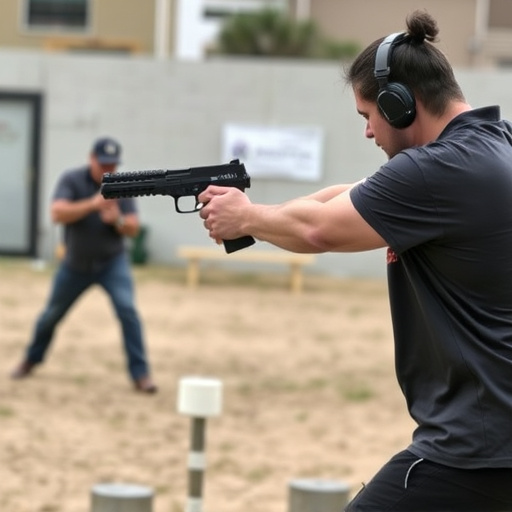Regional laws on concealed carry stun guns vary due to conflicting priorities between public safety and individual rights. Regulations aim to control their use with age limits, training, background checks, power output restrictions, and design guidelines. Long-term neurological stun effects are a growing medical concern, with studies suggesting potential chronic issues like sensory disturbances and cognitive deficits. Current regulations often struggle to keep pace with technological advancements and the increasing availability of stun guns, necessitating comprehensive guidelines balancing deterrence and risk. As research continues on long-term effects, future legislation may include stricter accessibility restrictions, enhanced training, age limits, tracking measures, and advanced technology emphasizing safer usage.
“In an era of evolving personal safety measures, concealed carry stun guns have emerged as a controversial yet potentially life-saving option. This article delves into the intricate web of regulations surrounding these devices, exploring the legal framework that governs their possession and use. We dissect the health impacts, both short-term and the often overlooked long-term neurological effects, and examine public safety concerns. Furthermore, we peek into future legislative trends, offering insights into how stun gun legislation might adapt to meet societal needs.”
- Legal Framework for Concealed Carry Stun Guns
- Short-Term vs Long-Term Health Impacts
- Regulatory Challenges and Public Safety Concerns
- Future Trends in Stun Gun Legislation
Legal Framework for Concealed Carry Stun Guns

The legal framework governing concealed carry stun guns varies widely across jurisdictions, reflecting a complex interplay between public safety and individual rights. At the heart of this debate lies the delicate balance between allowing citizens to protect themselves and ensuring that such devices are used responsibly and within ethical boundaries. Regulations often include strict age requirements, mandatory training courses, and background checks to assess fitness and intent. Additionally, many areas impose restrictions on the type of stun guns allowed, focusing on power output and safety features, while also considering the potential for long-term neurological stun effects.
These laws are designed to prevent misuse and accidental harm, especially considering the unique challenges posed by stun devices. The variability in regulations underscores the need for ongoing discussions and research into both the effectiveness of stun guns in self-defense scenarios and their possible adverse health impacts, including long-term neurological stun effects. Such dynamic legislation aims to adapt to technological advancements while maintaining a robust safety net for all citizens.
Short-Term vs Long-Term Health Impacts

While the immediate effects of a stun gun are evident—disorienting the target with powerful electrical pulses—the long-term health impacts are less understood. Short-term, individuals may experience muscle weakness, disorientation, and temporary paralysis. However, the potential for more severe, Long Term Neurological Stun Effects remains an area of growing interest in the medical community. Studies suggest that repeated exposure to stun gun shocks could lead to chronic neurological issues, including persistent sensory disturbances, cognitive deficits, and even altered brain function. These effects may manifest differently across individuals, with some experiencing subtle changes and others facing more debilitating outcomes.
Research into this area is ongoing, as the rapid proliferation of stun guns for concealed carry purposes necessitates a deeper understanding of their long-term effects on human health. As technology advances, so do our capabilities to harness and utilize these devices; equally important is our responsibility to comprehend their broader implications.
Regulatory Challenges and Public Safety Concerns

Regulatory challenges around concealed carry stun guns present a complex web of considerations. One significant hurdle is understanding and addressing public safety concerns, particularly those related to unexpected or excessive use of force. The presence of stun devices in public spaces raises questions about potential misuse, accidental discharge, and their impact on individuals with pre-existing medical conditions, especially long term neurological effects.
Current regulations often struggle to keep pace with technological advancements, making it difficult to establish comprehensive guidelines for responsible stun gun ownership. Balancing individual rights and public safety demands a nuanced approach that considers both the device’s potential as a deterrent and its risks. Effective regulation requires ongoing research into the long-term neurological stun effects and collaboration between law enforcement, policymakers, and experts in order to ensure public safety without unduly infringing on personal freedoms.
Future Trends in Stun Gun Legislation

As research continues into the long-term neurological stun effects, it’s likely that legislation will evolve to reflect emerging scientific understanding. Future trends may include stricter regulations on stun gun accessibility and usage, with a focus on mitigating potential health risks. This could involve more comprehensive training requirements for users, age restrictions, and limited availability based on demonstrated need or professional necessity.
Additionally, the legal framework might incorporate provisions for better tracking and accountability to monitor the impact of stun guns on public safety. With advancements in technology, there may be a push towards smarter, safer stun devices that integrate features like automated de-activation mechanisms and enhanced user feedback systems, further emphasizing responsible usage and minimizing unintended consequences.
As we’ve explored, the legal framework surrounding concealed carry stun guns is complex, with significant public safety concerns balanced against individual rights. While short-term effects are often clear, further research into long-term neurological stun effects is crucial for informed policy-making. Navigating regulatory challenges requires a multifaceted approach that considers both public health and personal liberty. Looking ahead, future trends in stun gun legislation will likely reflect evolving societal values and technological advancements, underscoring the need for ongoing dialogue and adaptive laws to ensure safety without compromising constitutional rights.
